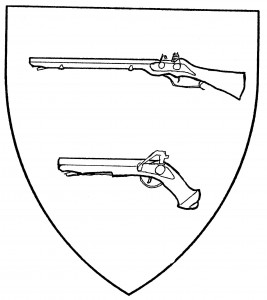The term “gun” is used here to mean any firearm held and used in the hand (as opposed to, e.g., cannons or mortars). This category of weapon includes the “musket” and the “arquebus”, long-barrelled firearms with shoulder stocks (the top charge in the illustration); and the “pistol” or “handgun”, less accurate but capable of being fired in one hand (the bottom illustrated charge). Such weapons are period: the arquebus was in use by the late 14th Century [Stone 71]. They were also used as period heraldic charges: a handgun, with a large bore and a small handle, is found in the canting arms of Gonson, c.1520 [DBA1 56]; a long gun with a strap (presumably an arquebus) was the canting badge of John Gunthorpe, Dean of Wells (d.1498) [Siddons II.2 335].
Any type of gun is acceptable in Society armory, so long as it was known in period: matchlock, wheellock, and flintlock weapons are all permitted. A firearm “proper” has a brown wooden stock and black metal parts; it is fesswise, muzzle to dexter by Society default.
See also cannon, pole-cannon.
Aonghas Galloglach Domnhnullach bears: Azure, a bend sinister sable and Or between in chief a flintlock pistol bendwise sinister, barrel to base argent, and in base a sword bendwise sinister and a sword bendwise sinister inverted, both proper.
Caoimhin mac Reagan bears: Gules, on a saltire Or between in pale a tower and a boar’s head couped close argent, two matchlock muskets in saltire proper, barrelled argent.
Gabriel Hawke the Gunsmith bears: Per pale azure and argent, in fess a hawk displayed belled and jessed per pale argent and sable between two wheel-lock pistols palewise triggers to center argent and sable.
